“Barbaric,” They Say
Recently, Dateline NBC televised an exposé on the fur-apparel industry, specifically on the production of the popular Russian broadtail fur. Broadtail fur comes from Karakul lambs, primarily in Russia and central Asia. Though fur apparel has long been controversial, the argument was made that most fur — lamb especially — is a byproduct of the meat trade. Hence, such apparel is not borne of what the faint-hearted consider wanton slaughter. (Keep in mind that the Catechism considers it “legitimate to use animals for food and clothing” [n. 2417, emphasis added].) But the problem with broadtail fur (for Dateline NBC) is that it must be taken from unborn baby lambs.
Rick Swain, chief investigator of The Humane Society of the U.S., says on the program, “The most valuable broadtail pelts come from baby lambs that are taken from their mothers by killing the mothers anywhere from 30 days before their natural birth date, up to right the day before” — in other words, by aborting the unborn lamb, whose fur is of superior quality and garners top dollar. Swain derides the method as “barbaric,” and doesn’t see how anyone “with any bit of humanity or conscience could know how this product is made and then wear it.” And Dateline NBC reporter Chris Hansen agrees.
You May Also Enjoy
Nowadays the old notion that a Catholic college ought to teach Catholicism to undergraduates seems not even to be seriously considered.
Why does neocon George Weigel defend Condi Rice, a pro-war and pro-abortion member of the Bush administration?
In his book review in the April NOR, Dale Vree asked rhetorically, “Who is God…

